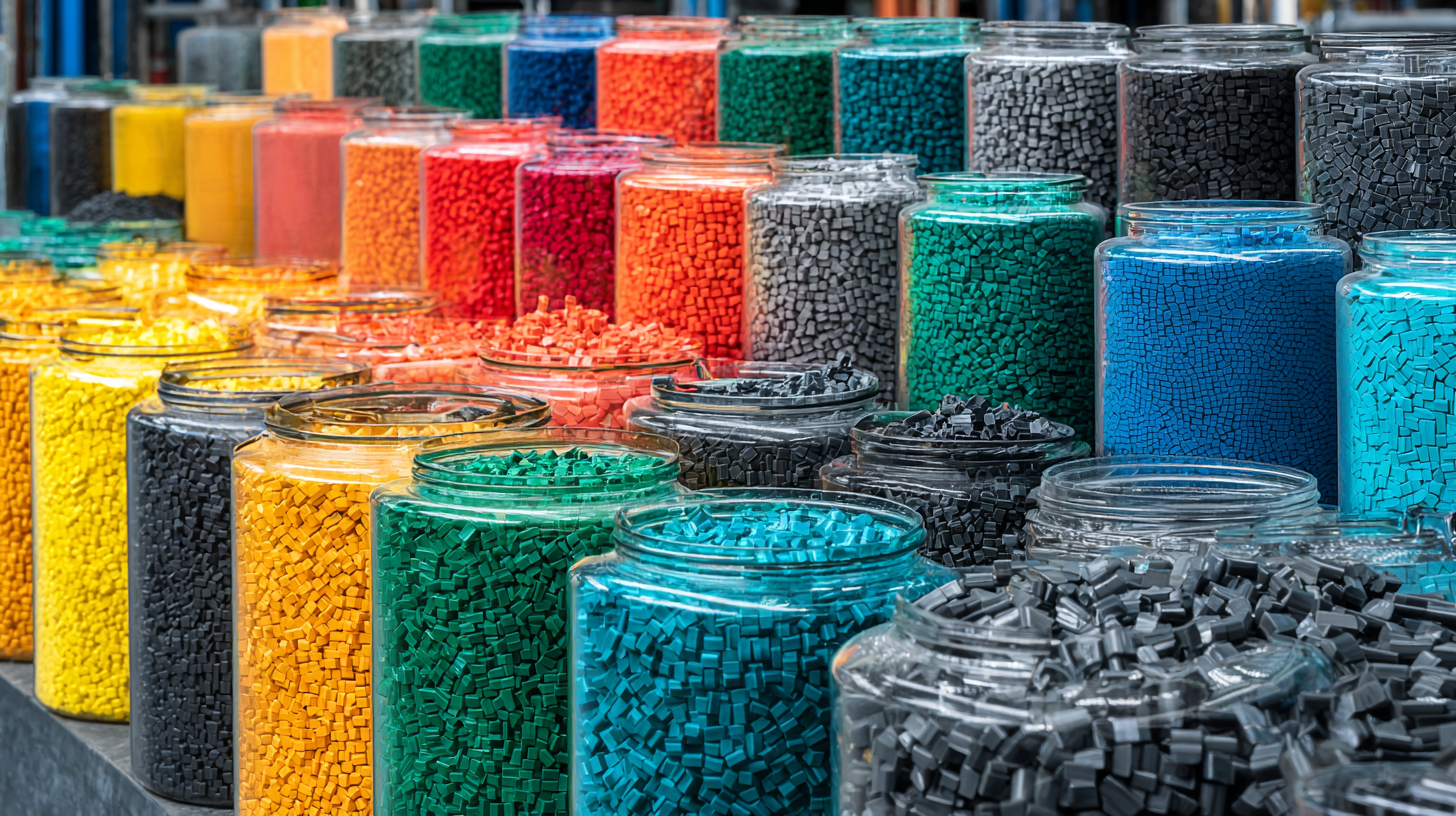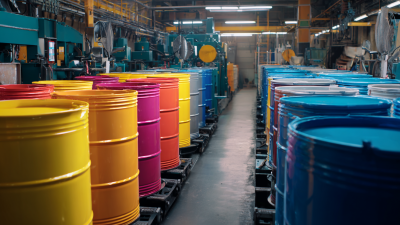- Home
- Masterbatch
- Additive Masterbatch
- Anti-Block Masterbatch
- Anti-Fog Masterbatch
- Anti-Microbial Masterbatch
- Anti-Oxidant Masterbatch
- Anti-Static Masterbatch
- Anti-Termite & Rodent Masterbatch
- Desiccant / Anti-Moisture Masterbatch
- Optical Brightener Masterbatch
- Flame Retardant Masterbatch
- Slip Masterbatch
- Polymer Processing Aid (PPA) Masterbatch
- UV Masterbatches
- VCI Additive Masterbatch
- Filler Masterbatch
- Black Masterbatch
- White Masterbatch
- Color Masterbatch
- Mono Masterbatches
- Special Effect Masterbatches
- EVA Masterbatch
- OXO Biodegradable Masterbatch
- XLPE Masterbatch
- Cable Masterbatch
- Nylon Masterbatch
- TPU Masterbatch
- Additive Masterbatch
- Compound
- Market
- Company
- Blog
- Contact Us
Exploring the Benefits of Compound Masterbatch: Industry Trends and Performance Metrics for 2024
In recent years, the plastics industry has seen a significant shift towards the adoption of compound masterbatch, a concentrated mixture of additives and pigments delivered in a carrier resin, which enhances the versatility and performance of end products. According to a report by Markets and Markets, the compound masterbatch market is projected to grow from USD 4.2 billion in 2023 to USD 5.8 billion by 2028, reflecting a robust annual growth rate of over 6%. This rising trend is driven by the increasing demand for high-performance materials in sectors such as packaging, automotive, and consumer goods, where customization and sustainability are becoming critical factors. Performance metrics indicate that compound masterbatch not only improves product quality but also optimizes processing efficiency, making it an invaluable asset for manufacturers. As we explore the benefits of compound masterbatch in 2024, understanding these industry trends will be crucial for stakeholders aiming to leverage these advancements for competitive advantage.

Understanding Compound Masterbatch: Definition and Key Components
Compound masterbatch is a concentrated mixture of additives and pigments, primarily used to enhance the properties of base polymers. This innovative material is typically prepared in a controlled environment to ensure uniform dispersion of ingredients, which can include colorants, fillers, and various performance additives such as UV stabilizers and flame retardants. According to a report by the International Polymer Science and Technology Journal, the use of compound masterbatch allows manufacturers to achieve superior color consistency and improved processing efficiency in their production lines, with reports indicating up to a 20% increase in productivity when compared to traditional colorant methods.
The key components of any compound masterbatch include the base resin, additives, and the desired pigments. The choice of base resin, whether polyethylene, polypropylene, or polystyrene, dictates the final application and performance characteristics of the masterbatch. In a recent study by Global Market Insights, the compound masterbatch market is projected to grow at a CAGR of 5.6% through 2024, driven by the increasing demand for high-performance materials in industries such as automotive, packaging, and consumer goods. This growth can largely be attributed to advancements in formulation technology and the growing emphasis on sustainability, as manufacturers seek to develop eco-friendly products that do not compromise on quality or performance.
Current Trends in Compound Masterbatch Usage Across Industries
The compound masterbatch market is witnessing significant growth across various industries due to its versatility and performance enhancements. Recent projections indicate that the global masterbatch market was valued at approximately USD 11.9 billion in 2024, with expectations to soar to USD 21.6 billion by 2034, reflecting a compound annual growth rate (CAGR) of 6.3%. This surge is largely attributed to evolving applications in key sectors such as packaging, automotive, and construction, where the demand for high-performance materials is on the rise.
In terms of specific applications, the plastic compounding market is estimated to reach USD 113.9 billion by 2033, driven by innovations in polymer technology and a booming construction sector. The diverse utilization of additive masterbatches, including antimicrobial, antioxidant, and flame retardant types, further illustrates the adaptability of compound masterbatches in enhancing product performance. The automotive plastic compounding market alone is expected to be worth USD 7.20 billion by 2034, with a CAGR of 6.84%, highlighting the critical role these materials play in meeting stringent industry standards and consumer demands for durability and safety.

Analyzing Performance Metrics of Compound Masterbatch for 2024
The compound masterbatch market is poised for significant growth in 2024, driven by rising demand across various industries, including packaging, automotive, and consumer goods. According to a recent report by Smithers Pira, the global demand for masterbatch is expected to reach 4.4 million tons by 2024, representing a CAGR of 5.2%. This trend highlights the increasing adoption of compound masterbatch due to its ability to enhance polymer properties, including color stability, UV resistance, and reduced processing costs.
Performance metrics will play a crucial role in assessing the effectiveness of compound masterbatch in fulfilling industry needs. Key performance indicators (KPIs) such as dispersion quality, material compatibility, and thermal stability will be critical for manufacturers looking to optimize their production processes. Research from Allied Market Research indicates that products incorporating high-quality compound masterbatch can see a reduction in defects by up to 30%, showcasing their role in reinforcing product reliability and longevity. As companies continue to innovate and refine their formulations, the emphasis on quantifiable performance metrics will help in establishing benchmarks that can advance the masterbatch industry's technological landscape in 2024.
Sustainability and Innovation in Compound Masterbatch Production
The production of compound masterbatch is rapidly evolving, underscored by sustainability and innovation as key drivers. As industries increasingly prioritize eco-friendly practices, the demand for sustainable compound masterbatch has surged, with the global market projected to reach approximately $3.5 billion by 2024, according to ResearchAndMarkets. This shift aligns with wider trends in polymer industries, where about 50% of manufacturers are adapting their processes to incorporate recycled materials and biodegradable additives, enhancing the environmental profile of their products.
Furthermore, innovation in production techniques is paving the way for higher performance metrics in compound masterbatch applications. Companies are investing heavily in R&D to develop formulations that not only meet but exceed industry standards. For instance, BASF’s annual report highlighted its 2023 investment of $50 million in sustainable masterbatch technology, resulting in a 25% reduction in carbon emissions during production. Such advancements illustrate the critical interplay between sustainability initiatives and product performance, ultimately driving the industry towards a greener and more efficient future. As we move into 2024, the focus on these aspects will only intensify, shaping the market landscape for compound masterbatches.
Exploring the Benefits of Compound Masterbatch: Industry Trends and Performance Metrics for 2024 - Sustainability and Innovation in Compound Masterbatch Production
| Index | Parameter | Value | Trend (2023-2024) |
|---|---|---|---|
| 1 | Production Capacity (tons/year) | 150,000 | +10% |
| 2 | Sustainability Index (1-10) | 8 | Stable |
| 3 | Recycled Content (%) | 30% | +5% |
| 4 | Average Energy Consumption (kWh/ton) | 350 | -8% |
| 5 | Customer Satisfaction Rate (%) | 87% | +3% |
Market Forecast: The Future of Compound Masterbatch in Manufacturing
The future of compound masterbatch in manufacturing is poised for significant growth, driven by rising demand for high-performance materials across various industries. As manufacturers increasingly prioritize sustainability, the shift towards bio-based and recycled materials will shape the compound masterbatch landscape in 2024. Companies are expected to innovate by formulating masterbatches that enhance product functionality while minimizing environmental impact, creating a win-win scenario for performance and responsibility.
When considering the integration of compound masterbatch in production, it’s essential to stay informed about emerging trends and technologies. **Tips:** Invest in understanding the specific properties of different masterbatches, as the right choice can significantly enhance the quality and longevity of your products. Also, engage with suppliers who focus on sustainable practices, as they can provide insights into how these materials impact both performance metrics and environmental goals.
Looking ahead, industry forecasts indicate a robust expansion in the consumption of compound masterbatch, particularly in sectors such as packaging, automotive, and consumer goods. This growth will be fueled by continuous advancements in processing techniques and modifications in polymer technology. **Tips:** Keep an eye on market developments, as adapting to these changes can provide a competitive edge. Additionally, consider participating in industry events to network with key players and gather insights that can directly benefit your production strategy.

Related Posts
-

Unlocking the Potential of Filler Masterbatch: Innovations in Polymer Manufacturing
-

Discover How Slip Masterbatch Revolutionizes Plastic Processing Efficiency
-

Unlocking the Future of Plastics: How Anti Block Masterbatch Enhances Packaging Performance
-

Revolutionizing Repair: Understanding the Science Behind Plastic Fillers and Their Environmental Impact
-

Unlocking the Benefits of Anti Block Masterbatch: Revolutionizing Plastics with Enhanced Performance
-

Unlocking Creative Potential: How Color Master Batches Transform Plastic Manufacturing
